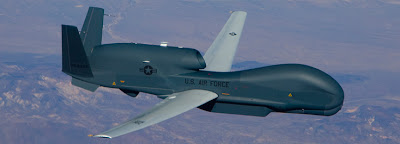An unmanned aircraft system (UAS) includes ground stations and other elements besides the actual aircraft, the term was first officially used by the FAA in early 2005 and subsequently adopted by DoD that same year in their Unmanned Aircraft System Roadmap 2005–2030.
US AIR FORCE GLOBAL HAWK
Many people have mistakenly used the term Unmanned Aerial System, or Unmanned Air Vehicle System, as these designations were in provisional use at one time or another. The inclusion of the term aircraft
emphasizes that regardless of the location of the pilot and flightcrew,
the operations must comply with the same regulations and procedures as
do those aircraft with the pilot and flightcrew on board. The official
acronym UAS is also used by the International Civil Aviation Organization (ICAO) and other government aviation regulatory organizations.
Global Hawk
A combat-proven HALE UAS with extraordinary ISR capabilities, providing near-real-time high resolution imagery of large geographical areas all day and night in all types of weather. The current Global Hawk enterprise is made up of four complimentary systems, or Blocks.
Block 10, the initial airframe after the DARPA technology demonstration, was deployed overseas shortly after the September 11, 2001 terrorist attacks and quickly proved its usefulness. Block 20, the first production version, was unveiled in August 2006. Block 30 adds critical signals intelligence (SIGINT) capability to the Global Hawk family.
Specifications:Block 10, the initial airframe after the DARPA technology demonstration, was deployed overseas shortly after the September 11, 2001 terrorist attacks and quickly proved its usefulness. Block 20, the first production version, was unveiled in August 2006. Block 30 adds critical signals intelligence (SIGINT) capability to the Global Hawk family.
Wingspan: 130.9 ft (39.9 m)
Length: 47.6 ft (14.5m)
Height: 15.4 ft (4.7 m)
Gross Take-off Weight: 32,250 lbs. (14,628 kg)
Maximum Altitude: 60,000 lbs (18.3 km)
Payload : 3,000 lbs (1,360 kg)
Ferry Range: 12,300 nm (22,780 km)
Loiter Velocity: 310 knots True Air Speed (TAS)
On-station Endurance at 1,200 nm: 24 hrs
Maximum Endurance: 32+hrs
BAMS UAS undergoing final assembly at Northrop Grumman's factory.
UAV design and production is a global activity, with manufacturers all across the world. The United States and Israel
were initial pioneers in this technology, and U.S. manufacturers had a
market share of over 60% in 2006, with U.S. market share due to increase
by 5–10% through 2016.
Northrop Grumman and General Atomics are the dominant manufacturers in this industry, on the strength of the Global Hawk and Predator/Mariner systems.
According to the Stockholm International Peace Research Institute, Israeli companies were behind 41% of all UAVs exported in 2001-2011. The European market share represented just 4% of global revenue in 2006.
Development costs for American military UAVs, as with most military
programs, have tended to overrun their initial estimates. This is mostly
due to changes in requirements during development and a failure to
leverage UAV development programs over multiple armed services. This has
caused United States Navy UAV programs to increase in cost from 0% to 5% while United States Air Force UAV programs have increased from 60% to 284%.
Source:
Northrop Grumman


























No comments:
Post a Comment